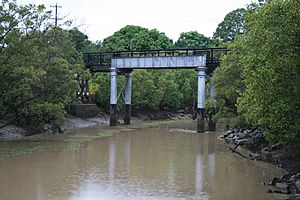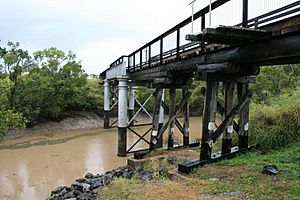Saltwater Creek Railway Bridge facts for kids
Quick facts for kids Saltwater Creek Railway Bridge |
|
|---|---|

Saltwater Creek Railway Bridge, 2009
|
|
| Location | from Quay Street, Bundaberg Central to Bundaberg East, Bundaberg, Bundaberg Region, Queensland, Australia |
| Design period | 1870s - 1890s (late 19th century) |
| Built | 1894 - 1894 |
| Official name: Saltwater Creek Railway Bridge, Millaquin Bridge | |
| Type | state heritage (built) |
| Designated | 21 October 1992 |
| Reference no. | 600370 |
| Significant period | 1890s (fabric) |
| Significant components | abutments - railway bridge, pier/s (bridge) |
| Builders | James Overend |
| Lua error in Module:Location_map at line 420: attempt to index field 'wikibase' (a nil value). | |
The Saltwater Creek Railway Bridge is an old train bridge in Bundaberg, Queensland, Australia. It crosses Bundaberg Creek, which is also called Saltwater Creek. The bridge connects Bundaberg Central to Bundaberg East. It was built a long time ago, in 1894, by a person named James Overend. Some people also know it as the Millaquin Bridge. This bridge is very special because it's listed on the Queensland Heritage Register, which means it's an important historical site.
Contents
A Bridge's Story
In the 1880s, people in Bundaberg really wanted a railway line to the Woongarra area. They thought it would help with sugar transport. A plan for the railway was drawn up between 1889 and 1891.
Since the government didn't have money to build it, a man named Robert Cran stepped in. He owned the Millaquin sugar refinery near Bundaberg. In 1892, a special law allowed him to build a private railway from Bundaberg to his sugar refinery.
Building the Bridge
Plans for the bridge were made in 1893. The government asked companies to bid on building it. In January 1894, the job was given to James Overend. The railway line, including this bridge, opened for trains on 9 July 1894.
Government Takes Over
The railway line was privately owned for a while. But on 3 December 1912, the Queensland Government bought it. Later, in 1917, another law allowed the government to buy the railway's extension to Woongarra. By 1918, the government owned the entire railway line.
In 1965, engineers made plans to make the bridge stronger. They added steel beams to help it carry heavier loads, like modern trains. These steel beams were actually reused from another bridge on the Gold Coast.
What the Bridge Looks Like
The Saltwater Creek bridge is made up of several parts. It has one large steel section that is about 50-foot (15 m) long. This part uses strong steel plates and cross beams.
The rest of the bridge is made from timber. It has seven sections that are 20-foot (6.1 m) long and two sections that are 26-foot (7.9 m) long. These timber sections are held up by different kinds of supports.
Bridge Supports
The bridge stands on several supports called piers and abutments. There are seven timber piers, two concrete cylinder piers, and two timber abutments. Abutments are the parts that connect the bridge to the land on each side. Some of the piers have special "screw piles" at their base. These are like giant screws that go deep into the ground to hold the bridge firmly in place.
Why the Bridge is Important
The Saltwater Creek Railway Bridge was added to the Queensland Heritage Register on 21 October 1992. This means it's a very important historical site.
A Piece of History
This bridge is important because it shows how Queensland's history developed. It was built in the late 1800s. It's also special because it's one of the oldest bridges in Queensland that uses screw piles. Even though it was built as a private railway, it was made to the same high standards as government railways.


